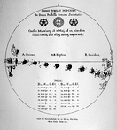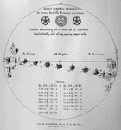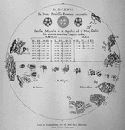
Christoph Scheiner (1573-1650)
Christoph Scheiner was born in Wald, near Mindelheim in Swabia (southwest Germany), on 25 July 1573. He attended the Jesuit Latin school in Augsburg, continued his studies in the Jesuit college at Landsberg, and entered the Jesuit order in 1595. Having completed his preparatory study, he entered the university at Ingolstadt in 1600. Here he studied metaphysics and devoted himself to the study of mathematics. In 1610 he joined the faculty of the Jesuit college of the university as professor of Mathematics and Hebrew.
Scheiner's talents lay in the mathematical sciences and instruments. Early in his career he became an expert on the mathematics of sundials and also invented a pantograph (a device for copying and enlarging drawings). Upon hearing about Galileo's discoveries with the telescope, in 1610, Scheiner immediately set out to obtain good telescopes with which to scrutinize the heavens. After verifying Galileo's discoveries for himself, he turned his attention to the Sun, where, in March or April 1611, he discovered sunspots. He was neither the first to observe sunspots nor the first to publish on the subject, but his publication was the start of a controversy with Galileo over the nature of sunspots.
Because of the conservative stand of the Jesuit order on cosmological issues, Scheiner attempted to rescue the perfection of the Sun, and by implication the heavens generally, from imperfection. He therefore postulated that sunspots were caused by satellites of the Sun whose shadows are projected on to Sun's disk as they cross in front of it. His tract, Tres Epistolae de Maculis Solaribus ("Three Letters on Solar Spots") appeared in Augsburg early in 1612, under the pseudonym "Apelles latens post tabulam," or "Apelles hiding behind the painting." These letters were written to Marc Welser, an Augsburg banker and scholar who was a friend and patron to Jesuit scholars.
Welser invited Galileo to comment on these letters, and Galileo responded with two letters to Welser of his own in which he argued that sunspots are on or near the surface of the Sun, that they change their shapes, that they are often seen to originate on the solar disk and perish there, and that therefore the Sun is not perfect. In the meantime, Scheiner had written two further letters to Welser on this subject, and after reading Galileo's first letter he wrote yet another. This second series of three letters was published by Welser in the fall of 1612, with the title De Maculis Solaribus et Stellis circa Iovis Errantibus Accuratior Disquisition ("A More Accurate Disquisition Concerning Solar Spots and Stars [i.e., Satellites] Wandering around Jupiter"). Again, Scheiner used the pseudonym of Apelles. Scheiner restated his argument that sunspots were caused by satellites and argued that Jupiter had more satellites than the four discovered by Galileo. Upon reading this tract, Galileo wrote yet a third sunspot letter to Welser, dated December 1612, and in 1613 the Lyncean Academypublished all three letters under the title Istoria e Dimostrazioni intorno alle Macchie Solari e loro Accidenti ("History and Demonstrations Concerning Sunspots and their Properties.") A third of the copies contained reprints of Scheiner's two tracts. Although he was polite to Scheiner, Galileo refuted his arguments and there was little doubt as to who was the winner of this dispute.
Scheiner went on to publish books on atmospheric refraction and the optics of the eye, and in these works he built on the optical achievements of Johannes Kepler, thus providing important material for later writers on the subject. He also continued his research on sunspots. In the meantime, he had begun instructing Arch Duke Maximilian, brother of Emperor Rudolph II, in the mathematical subjects, and in 1616 he left Ingolstadt for good to become Maximilain's advisor. Scheiner henceforth had the patronage of the Emperor's brother and in 1621 he became the confessor of Arch Duke Karl, brother of the new Emperor, Ferdinand II. One of Scheiner's greatest achievements was the foundation of a new Jesuit college in Neisse in Silesia. When the Arch Duke died on a voyage to Spain in 1624, Scheiner went to Rome, where he stayed for the next eight years. It was in Rome that he published his greatest work, Rosa Ursina (1630), the standard work on sunspots for more than a century.
In his Assayer of 1623, Galileo had made certain disparaging remarks about those who had tried to steal his priority of discovery of celestial phenomena. Although Galileo almost certainly had others in mind, Scheiner interpreted these remarks as being directed against him. He therefore devoted the first book of Rosa Ursina to an all out attack on Galileo, and it has been said that his enmity toward Galileo was instrumental in starting the process against the Florentine in 1633. Scheiner's diatribe against Galileo does, however, not take away from the importance of Rosa Ursina. Here Scheiner agreed with Galileo that sunspots are on the Sun's surface or in its atmosphere, that they are often generated and perish there, and that the Sun is therefore not perfect. Scheiner further advocated a fluid heavens (against the Aristotelian solid spheres), and he pioneered new ways of representing the motions of spots across the Sun's face. Because shortly after the appearance of Rosa Ursina sunspot activity decreased drastically (the so-called Maunder Minimum, ca. 1645-1710), his work was not superseded until well into the eighteenth century.
In 1633 Scheiner returned to the German region, where he spent the rest of his life in Vienna and Neisse, supervising the building of the Jesuit college. Until the end, he worked on a massive refutation of the Copernican theory, the finished part of which was published posthumously, in 1650, under the title Prodromus pro Sole Mobili et Terra Stabili contra Galilaeum a Galileis ("Introductory Treatise in Favor of a Moving Sun and a Stable Earth against Galileo Galilei"). The work remained virtually unkown and had no effect on the outcome of the debate between Copernicans and advocates of the geocentric/geostatic cosmology.
Sunspots (Rosa Ursina,
1630) |
Sources: William R. Shea, "Scheiner, Christoph," Dictionary of Scientific Biography; idem, "Scheiner, and the Interpretation of Sunspots," Isis, 61 (1970):498-519; idem, "Galileo, Sunspots and Inconstant Heavens," a chapter in his book, Galileo's Intellectual Revolution; Middle Period (1610-1632) (New York: Science History Publications, 1972), pp. 49-74. Stillman Drake, "Sunspots, Sizzi, and Scheiner," Galileo studies: personality, tradition, and revolution (Ann Arbor: University of Michigan Press, 1970), pp. 177-199; Grant McColly, "Christoph Scheiner and the Decline of neo-Aristotelianism," Isis, 32 (1940):63-69; Jean Dietz Moss, "The Significance of the Sunspot Question," a chapter in her book Novelties in the Heavens: Rhetoric and Science in the Copernican Controversy (Chicago: University of Chicago Press, 1993), pp. 97-125.
Last updated
Science | Christianity | Library | About | Site Map | Search
Please note: We will not answer copyright requests.
See the copyright page for more
information.













